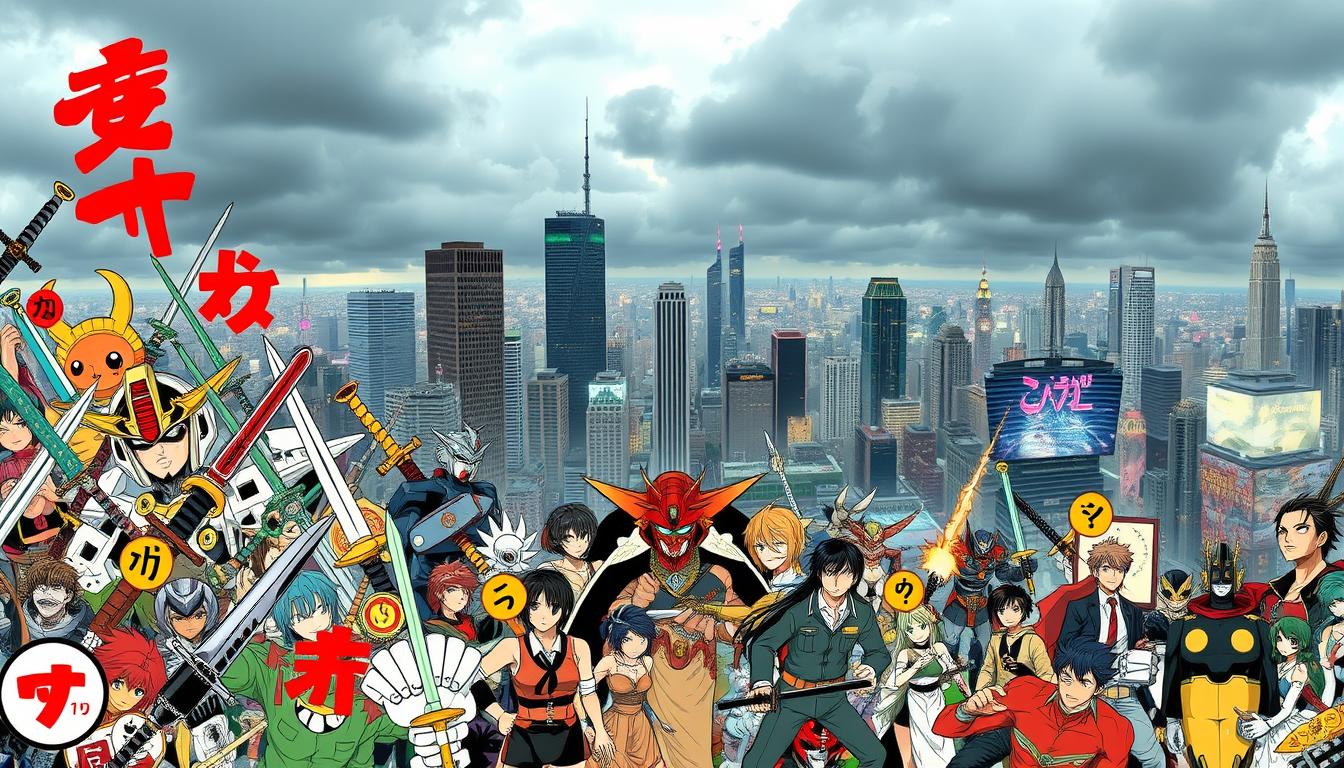Step into the vibrant world of Japanese comics, where storytelling knows no bounds and imagination comes alive. With a rich history and diverse genres, this captivating form of entertainment has become a global phenomenon, captivating audiences of all ages.
 The world of manga is vast and varied, offering something for everyone. From action-packed adventures to heartwarming romances, the range of manga series available is staggering, ensuring that readers can find their perfect match.
The world of manga is vast and varied, offering something for everyone. From action-packed adventures to heartwarming romances, the range of manga series available is staggering, ensuring that readers can find their perfect match.
Key Takeaways
- Explore the diverse genres and styles of manga.
- Discover the rich history and cultural significance of Japanese comics.
- Find the best manga series to suit your reading preferences.
- Learn about the global impact of manga on popular culture.
- Get introduced to new and exciting manga series.
What is Manga? Understanding Japanese Comics
Manga, a term that has become synonymous with Japanese comic culture, has a rich history and distinct characteristics. It is a form of comic storytelling that has evolved over centuries, influenced by various cultural and historical factors.
The Definition and Origins of Manga
Manga is defined as a style of Japanese comic books or graphic novels that are typically printed in black and white. The origins of manga date back to the 12th century, with the emergence of Toba Sojo's caricatures and later influenced by Western comic styles during the Meiji period. The term "manga" was first used in the late 18th century.
The modern manga industry began to take shape in the post-World War II era, heavily influenced by Osamu Tezuka, often referred to as the "God of Manga." His works, such as Astro Boy, not only popularized manga but also laid the groundwork for the modern industry.
PeriodInfluence/EventNotable Works/Artists12th CenturyEmergence of early manga formsToba Sojo's caricaturesMeiji Period (1868-1912)Influence of Western comicsIntroduction of Western-style drawing techniquesPost-WWIIModern manga industry beginsOsamu Tezuka's Astro Boy
Distinguishing Features of Manga Art Style
Manga is characterized by its unique art style, which includes exaggerated facial expressions, dynamic panel layouts, and a right-to-left reading format. The visual storytelling in manga often combines text and image in creative ways, enhancing the narrative.
The art style varies across different genres, from the action-packed sequences in shonen manga to the intricate details found in seinen manga. Understanding these visual cues is key to appreciating the complexity and depth of manga storytelling.
The Rich History of Manga
The history of manga is a long and fascinating one, deeply rooted in Japanese art and culture. Manga, which translates to "whimsical pictures," has evolved over the centuries, influenced by various aspects of Japanese society and historical events.
Early Beginnings in Japanese Art
Manga's origins can be traced back to ancient Japanese art forms, such as ukiyo-e, which were woodblock prints that told stories and depicted scenes from everyday life. These early art forms laid the groundwork for the development of manga's unique visual style and narrative techniques.
Post-War Evolution and Osamu Tezuka's Influence
The modern concept of manga began to take shape in the post-World War II era, largely due to the influence of Osamu Tezuka, often referred to as the "God of Manga." Tezuka's works, such as Astro Boy, revolutionized the manga industry with their dynamic storytelling and cinematic visuals. His influence paved the way for future generations of manga artists.
https://www.youtube.com/watch?v=wSof7ehixNw
Modern Manga Industry Development
Today, the manga industry is a thriving sector in Japan, with a diverse range of genres and styles catering to various audiences. The industry has also become more global, with many manga series being translated and adapted into other media, such as anime and live-action films.
EraKey DevelopmentsInfluential FiguresAncient JapanEarly forms of narrative art, such as ukiyo-eHokusaiPost-WWIIModern manga begins to take shapeOsamu TezukaModern EraDiverse genres, global popularityEichiro Oda, Masashi Kishimoto
Manga vs. Anime: Understanding the Differences
Understanding the differences between manga and anime is crucial for appreciating Japanese pop culture. While both are popular forms of entertainment, they have distinct characteristics that set them apart.
Original Source vs. Adaptation
Manga is typically the original source material, with stories and characters created by mangaka (manga artists). Anime, on the other hand, is often an adaptation of manga, bringing the static images to life through animation. As Eiichiro Oda, creator of One Piece, once noted, "Manga is my medium of expression, and anime is a different form of expression based on my work."
"Manga is like a novel, while anime is like a movie."
Creative Differences and Advantages of Each Medium
The creative processes for manga and anime differ significantly. Manga relies on the reader's imagination to fill in the gaps between static images, while anime provides a more immersive experience with moving images and sound. According to a study comparing manga and anime adaptations, the table below highlights some key differences:
AspectMangaAnimeStorytelling MethodStatic images with textAnimated sequences with audioPacingReader-controlledFixed pacingImaginationRequires reader imaginationProvides a more immersive experience
In conclusion, both manga and anime have their unique strengths, offering different ways to experience a story. Whether you prefer the detailed artwork of manga or the dynamic animation of anime, understanding their differences can enhance your appreciation of Japanese pop culture.
Exploring Popular Manga Genres
From action-packed adventures to sophisticated romances, manga genres have something for everyone. The diversity in manga caters to a wide range of audiences, from children to adults, and encompasses various themes and storytelling styles.
Shonen: Action-Packed Adventures for Young Boys
Shonen manga is known for its energetic and often comedic storylines, typically aimed at a male audience. These series frequently feature male protagonists and are characterized by their fast-paced action sequences.
Notable Shonen Series and Their Impact
Series like Dragon Ball and Naruto have become cultural phenomena, influencing not just manga and anime but also other forms of media. Their impact on the shonen genre is undeniable, setting standards for action-packed storytelling.
Shojo: Romance and Drama for Young Girls
Shojo manga targets a young female audience, focusing on themes of romance, friendship, and personal growth. These stories often explore the emotional lives of their characters, providing relatable content for readers.
Influential Shojo Manga Through the Years
Classics like Sailor Moon and Fruits Basket have paved the way for future shojo manga, offering a mix of romance, drama, and fantasy that continues to captivate audiences.
Seinen: Mature Themes for Adult Men
Seinen manga is geared towards an adult male demographic, tackling more mature themes such as politics, psychology, and complex moral issues. These series often feature more sophisticated storytelling and artwork.
Groundbreaking Seinen Works
Titles like Akira and Gantz have pushed the boundaries of manga storytelling, exploring dark and complex themes that resonate with adult readers.
Josei: Sophisticated Stories for Adult Women
Josei manga is designed for an adult female audience, delving into more mature and realistic portrayals of women's lives, including relationships, careers, and societal expectations.
 Manga GenreTarget AudienceCommon ThemesShonenYoung MalesAction, Adventure, FantasyShojoYoung FemalesRomance, Drama, FriendshipSeinenAdult MalesPolitics, Psychology, Complex MoralityJoseiAdult FemalesMature Relationships, Career, Societal Expectations
Manga GenreTarget AudienceCommon ThemesShonenYoung MalesAction, Adventure, FantasyShojoYoung FemalesRomance, Drama, FriendshipSeinenAdult MalesPolitics, Psychology, Complex MoralityJoseiAdult FemalesMature Relationships, Career, Societal Expectations
Understanding these genres helps readers navigate the vast world of manga, finding content that suits their interests. Whether you're drawn to action, romance, or complex drama, there's a manga genre out there for you.
Classic Manga Series That Defined the Medium
Certain manga series have transcended their origins to become cultural touchstones, influencing generations of readers and creators alike. These classic series have not only shaped the manga industry but continue to inspire new works and adaptations.
Dragon Ball: The Martial Arts Epic
Dragon Ball, created by Akira Toriyama, is one of the most iconic manga series of all time. It revolutionized the martial arts genre in manga, combining epic battles, character development, and a rich storyline that captivated a global audience.
Astro Boy: The Birth of Modern Manga
Astro Boy, or Tetsuwan Atom in Japanese, is considered a pioneering work in the manga industry. Osamu Tezuka's creation is often credited with inspiring the modern manga style and has influenced countless other creators.
Sailor Moon: Revolutionary Magical Girl Series
Sailor Moon, by Naoko Takeuchi, transformed the magical girl genre with its blend of action, romance, and adventure. The series has become a cultural phenomenon, inspiring numerous adaptations and remaining beloved by fans worldwide.
Naruto: The Ninja Coming-of-Age Story
Naruto, created by Masashi Kishimoto, is a quintessential coming-of-age story set in a ninja world. The series has resonated with readers globally, thanks to its themes of perseverance, friendship, and self-discovery.
Other Influential Classic Series
Other notable classic manga series include Gundam, Akira, and Ghost in the Shell. These works have contributed significantly to the diversity and richness of the manga medium, influencing various genres and inspiring new generations of manga artists.
The Best Manga Series of the Modern Era
Modern manga series have not only gained immense popularity but have also significantly influenced the global pop culture landscape. These series have captivated audiences with their unique storytelling, memorable characters, and stunning artwork.
The modern era of manga is characterized by a diverse range of genres and themes, catering to different demographics and interests. From action-packed adventures to heartfelt romances, modern manga series have something to offer for every kind of reader.
One Piece: The Best-Selling Manga of All Time
One Piece is a cultural phenomenon, having become the best-selling manga series of all time. Created by Eiichiro Oda, it follows the adventures of Monkey D. Luffy and his crew as they search for the ultimate treasure known as "One Piece." With over 1000 chapters, it is known for its intricate storyline, memorable characters, and themes of friendship and perseverance.
Attack on Titan: A Dark Fantasy Phenomenon
Attack on Titan, created by Hajime Isayama, is a dark fantasy series that has taken the world by storm. The story is set in a world where humanity is on the brink of extinction, with giant humanoid creatures known as Titans threatening their very existence. It is praised for its dark and suspenseful storyline, as well as its exploration of themes such as survival, sacrifice, and the human condition.
My Hero Academia: Superhero Action with Heart
My Hero Academia, created by Kohei Horikoshi, is set in a world where superpowers are the norm. The series follows Izuku Midoriya, a young boy who dreams of becoming a hero despite being born without powers in a world where they are the norm. It is known for its blend of action, humor, and heartfelt moments, as well as its exploration of themes such as friendship, perseverance, and the true meaning of being a hero.
Demon Slayer: The Record-Breaking Success Story
Demon Slayer: Kimetsu no Yaiba, created by Koyoharu Gotoge, is a dark fantasy adventure series that has achieved record-breaking success. The story follows Tanjiro Kamado, a young boy who becomes a demon slayer after his family is slaughtered by demons. It is praised for its stunning artwork, intense action sequences, and emotional storytelling.
Critically Acclaimed Recent Series
In addition to these popular series, there are many other critically acclaimed modern manga series. Some notable mentions include Jujutsu Kaisen, Chainsaw Man, and Dr. Stone, each offering unique storytelling and captivating artwork.
Manga SeriesGenreAuthorOne PieceAction, AdventureEiichiro OdaAttack on TitanDark Fantasy, ActionHajime IsayamaMy Hero AcademiaSuperhero, ActionKohei HorikoshiDemon SlayerDark Fantasy, AdventureKoyoharu Gotoge How to Read Manga: A Beginner's Guide
How to Read Manga: A Beginner's Guide
The art of reading manga involves more than just flipping through pages; it requires an understanding of its unique format.
Manga is typically read from right to left, a format that can be unfamiliar to Western readers. This difference in reading direction is rooted in traditional Japanese reading customs.
Understanding Right-to-Left Reading Format
The right-to-left format is a hallmark of manga. To adjust to this format, start by opening the book from what would be considered the "back" in Western publications. Then, begin reading from the page that is on your right.
This simple adjustment can significantly enhance your reading experience, allowing you to fully immerse yourself in the story and artwork.
Deciphering Panel Layouts and Visual Cues
Manga panel layouts are designed to guide the reader's eye through the story. Typically, the panels are read from right to left and top to bottom.
Visual cues, such as the size and placement of panels, are used to convey emphasis and pacing. Larger panels often highlight crucial moments in the story, while smaller panels can indicate quicker actions or dialogue.
Tips for New Manga Readers
To get the most out of your manga reading experience, start with series that are highly rated and well-reviewed. This can help you become accustomed to the different genres and art styles.
Additionally, be patient with yourself as you adjust to the right-to-left reading format. With practice, it will become second nature, allowing you to fully enjoy the world of manga.
Where to Find and Enjoy Manga
Whether you're a seasoned manga reader or just starting out, there are multiple ways to access and enjoy manga. The medium has evolved to cater to diverse reader preferences, offering both digital and physical formats.
Digital Manga Platforms and Apps
Digital platforms have revolutionized the way we consume manga. Services like Viz Media and Manga Plus offer vast libraries of titles, often with simultaneous releases alongside Japan. These platforms are convenient, allowing readers to access their favorite series anywhere, anytime.
Some popular digital manga platforms include:
- Manga Plus by Shueisha
- Viz Media's Digital Manga Platform
- Comixology
Physical Manga Collections and Bookstores
For many fans, physical manga collections are a cherished part of their hobby. Bookstores specializing in manga, such as Kinokuniya and Animerica, provide a tactile experience, allowing readers to browse and discover new titles. Physical copies are also collectible and can be shared or displayed.
StoreSpecialtyAvailabilityKinokuniyaManga, Anime GoodsOnline and Physical StoresAnimericaManga, Anime MerchandiseOnline and Select Physical Stores
Legal vs. Unofficial Sources
It's crucial to access manga through legal sources. This supports creators and publishers by ensuring they receive compensation for their work. As Eiichiro Oda, creator of One Piece, once emphasized, "Piracy is a serious issue that affects the entire industry."
"Piracy is a serious issue that affects the entire industry." -
Eiichiro Oda
Using legal sources also ensures a high-quality reading experience, free from the risks associated with unofficial sites, such as malware or low-resolution scans.
Conclusion: Embarking on Your Manga Journey
As we've explored the world of manga, it's clear that this unique form of storytelling has something to offer everyone. From the action-packed adventures of shonen series to the sophisticated tales of josei, the diversity of manga is vast and captivating. Whether you're drawn to classic series like Dragon Ball or modern hits like Attack on Titan, exploring manga can be a rewarding and exciting experience.
Now that you've learned about the different genres, how to read manga, and where to find it, you're ready to start your manga journey. With so many great series out there, it can be daunting to know where to begin. Consider what themes or genres interest you the most, and start with titles that resonate with your tastes. As you delve into the world of manga, you'll discover new favorites and broaden your understanding of this dynamic medium.
Embarking on your manga journey is not just about reading stories; it's about becoming part of a vibrant community. Join online forums, visit local comic bookstores, and share your thoughts with fellow fans. By exploring manga, you're not only enjoying great stories but also connecting with others who share your passions.
FAQ
What is manga?
Manga refers to Japanese comic books or graphic novels that are typically printed in black and white, although some are also published in color. The term "manga" is used to describe a wide range of genres and styles.
How do I read manga?
To read manga, start by understanding the right-to-left reading format, as most manga is published in this style. You can also familiarize yourself with the panel layouts and visual cues used in manga to enhance your reading experience.
What are the different genres of manga?
Some popular manga genres include shonen, shojo, seinen, and josei. Shonen manga is typically aimed at a male audience and features action-packed storylines, while shojo manga is geared towards a female audience and often focuses on romance and relationships. Seinen and josei manga are targeted towards adult men and women, respectively, and often feature more mature themes.
What is the difference between manga and anime?
Manga refers to the printed or digital comic book version of a story, while anime is the animated adaptation of that story. While some manga series are adapted into anime, not all anime is based on manga.
Where can I find manga?
You can find manga through digital manga platforms and apps, such as VIZ Media's Shonen Jump app or Comixology, as well as in physical manga collections and bookstores like Barnes & Noble or Books-A-Million. It's also important to use legal sources to support the creators and publishers.
Are there any classic manga series I should know about?
Yes, some classic manga series that have defined the medium include Dragon Ball, Astro Boy, Sailor Moon, and Naruto. These series have had a significant impact on the manga industry and continue to be popular today.
What are some popular modern manga series?
Some popular modern manga series include One Piece, Attack on Titan, My Hero Academia, and Demon Slayer. These series have achieved significant success and have been widely acclaimed by fans and critics alike.
Can I read manga online for free?
While some websites may offer free manga online, it's generally recommended to use legal sources, such as digital manga platforms or official publisher websites, to support the creators and publishers. Unofficial sources may be of poor quality or infringe on copyrights.



Comments ()